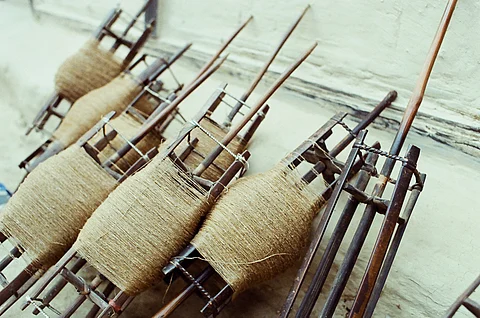
- Home
- Live Blog
- Breaking News
- Top Headlines
- Cities
- NE News
- Sentinel Media
- Sports
- Education
- Jobs

A CORRESPONDENT
BOKAKHAT: In the field of Eri (maggot) production, Assam once held a leading position in India. Through Eri production, Assam was able to preserve its art and culture while enabling Assamese people to become self-reliant. Over time, however, Eri has been neglected in Assam. Scientific Eri production has still not been adopted, causing some producers to become discouraged. Eri production can be undertaken with low capital investment. The Eri silk shawl remains popular in Assam even today. However, due to the lack of fair prices, the appeal of Eri silk seems to be fading.
The process of rearing Eri silkworms is quite simple. ERI rearing still plays a role in Assam’s rural economy, often without any special training. The environmental conditions necessary for Eri rearing are ideal in Assam as the region’s soil and climate support the growth of plants required for Eri silkworms. The best leaves for Eri silkworms come from the castor plant, though they also enjoy cassava leaves. In many states, castor is cultivated for its seeds. In Gujarat, Rajasthan, Andhra Pradesh, and other states, castor cultivation is done for seed production. In Assam, castor grows especially well in moist soil.
Eri rearers benefit in many ways. The price of Eri cocoons (locally called ‘leta’) is very good in the market — in Assam, it ranges from Rs 500 to Rs 1,200 per kilogram. Meanwhile, the price of an eri Silk garment ranges from Rs 4,000 to Rs 10,000 in Assam’s markets. Additionally, Eri waste serves as a valuable organic fertilizer. However, Assam still lacks a dedicated market for Eri silk. While many other states in India have developed specialized markets for products like fish and snails, similar initiatives for Eri have not been taken by the government.
In Assam, though July 3 is observed as ‘Eri Bandhu Day’ (Eri Friends Day), many Eri rearers are not even aware of this special day. It could be used to raise awareness about Eri. There is also an organization called Eri Friend in Assam. Yet, no significant campaign for Eri rearing has emerged in the state.
Among the four types of silk produced in Assam — Pat, Muga, Tussar, and Eri — Eri has the most influence on the rural economy. Eri silk is a scientifically proven fabric that regulates both heat and cold. It is an important material for national events in Assam.
From egg to cocoon, Eri silkworms take about 20–25 days in summer while in winter, this period increases. Eggs hatch into larvae within 5 to 7 days. Eri worms are small, with females being larger than males. After emerging from the cocoon, the moth dies. For egg-laying, female Eri moths are tied with Eri silk threads to suitable materials. Usually, 100 cocoons yield one skein of silk. Four skeins make up what rearers call one pua of silk.
For an eight-foot-long Eri cloth, about three pora (bundles) of long silk thread are needed. In summer, before weaving Eri thread, it is often treated with tamarind paste for smoother weaving. In rural Assam, Eri thread is still spun on the traditional spinning wheel (takuri). Some people also rear Eri for food, as Eri cocoons are edible. The cocoons are boiled in hot water with soda, following which the pupa is removed. Many people discard the empty shells, though some traders buy them at low prices. These shells spoil within a few days if untreated. The price of shells ranges from Rs 500 to Rs 1,000 per kilogram.
Officially, Assam is said to produce 5,000 metric tons of Eri silk annually. However, private production is believed to be less than 600 metric tons, and data suggests that production is declining. Karbi Anglong district produces the most Eri in Assam. Despite this, Assam has not yet developed a robust Eri-based industry. In the private sector, two notable initiatives have emerged: Rodrsagar Silk in Dimow and Fabric Plus in Sualkuchi. Both collect Eri cocoons from Assam and other parts of Northeast India. The government has a department for Eri production, but the extent of its support to producers remains questionable.
Generally, only one species of Eri silkworm is found in Assam, though a new variety called C-2 has recently been introduced.
Within India, the leading states in Eri production are Assam, Meghalaya, Nagaland, Manipur, and Uttar Pradesh. In 2015–16, production levels were: Assam: 78,515 metric tons, Meghalaya: 824 metric tons, Nagaland: 22 metric tons, Manipur: 370 metric tons, and Uttar Pradesh: 36 metric tons.
Also Read: Assam: Eri silk spinning training concludes at Pobitora Fringe
Also Watch: